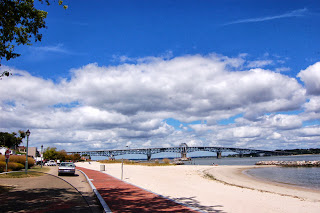To complete our tour of the Historical Triangle, we spent the day at the Town of Yorktown, the Victory Center (museum), and the battlefield. First we went to the battlefield which is maintained by the National Parks Service, so that our Pass got us in free. There is a nice display explaining the significance of the battle, the last major battle of the American Revolution. The formal surrender of the British under General Cornwallis to the combined Continental and French armies under Generals Washington and Rochambeau took place in a private residence of a prominent Yorktown resident.
The battlefield tour is a driving tour. Cd's are available for auto tours. At the building are the rebuilt earthworks the British threw up to deter the American forces after the British took Yorktown, a strategic harbor town, which is a short 400 yards or so to the west.
These earthworks were rebuilt on the originals by the CCC. The earthworks consisted of high mounds of dirt called redoubts lined with pointed logs to prevent access to the top where troops fired down on the enemy. The removed dirt left trenches that protected the hills. After the French navy stopped the British reinforcements from New York by sea, the French bombarded the earthworks with canon for three days before storming them and winning the battle.
Memorial cemetery
The driving tour took us through forests to open fields where the troops were quartered. At the time of the battle, there were no trees. All of the area was a large plantation of planted fields, such as the one below. At each area were historical markers to explain the significance of each stop.
The mound behind the sign is the only remaining original redoubt. You have to imagine it without the trees and higher.
Memorial erected between the battlefield and the town.
Yorktown was established in 1691 by an Act for Ports passed by the Virginia House of Burgesses. 50 acres were purchased next to the York River and the town was surveyed into 85 half-acre lots. By the early 1700s the town was a major port serving Williamsburg, the new capital of Virginia. The waterfront was full of wharves, docks, storehouses, and businesses. On the streets above the waterfront, stately homes of the wealthy merchants lined Main Street, with taverns and other shops scattered through the town. Yorktown was a crowded town with 200-250 buildings. The town reached its peak in the 1750's with a population of about 1800. When tobacco, the source of the trade system and basis of much of the town's wealth, had exhausted the soil of nearby plantations, planters began moving westward. Prominent families who would play important roles in Virginia during the Revolutionary War, still remained. The siege of 1781 destroyed so much of the town that by 1790 there were less than 70 buildings, and the population reduced to 661.
On the hill, several houses and other structures from the colonial period are still standing and give the town much of the character of a long-vanished era. Down the hill at the riverfront, you will find modern restaurants and shops for tourists. Although modern, they instill a feeling of a bustling center of commerce that once comprised the area.
The bridge is the one we crossed every day to visit the Historical Triangle areas. The bridge is free to enter the area, but charges a moderate toll to return.
We drove along the waterfront to access the Victory Center complex. Complex is small, relatively speaking, but is currently under expansion. The Complex is entered via the visitor entrance where tickets are purchased. We were hungry but wanted to fit in this complex before it closed so didn't eat in Yorktown. We found no food here but were directed to the vending machines where we cobbled together a lunch of sorts. From the entrance we entered the small replica of a 1780's farm. This was a mock up of what was usually a 200 or so self-sustaining farm of a middle-class family. It included a tobacco barn, small house, separate kitchen, crop field and vegetable and herb garden. We were encouraged to wander at our leisure, talking to historical interpreters who demonstrated typical rural lifestyle during the nation's formative years.
Cooking would have been done by women.
This woman was picking seeds from cotton bolls.
Replica of a planted field.
After the farm we visited the Continental Army encampment. This interpreter was explaining the tools and role of the camp surgeon.
Loading and shooting demo.
Field tents. (I used one of these when I was camping in the Fur Trade era and the War of 1812.)
After we roamed the encampment, we moved on to the museum. It was up to our standards--very informative with great displays and easy to follow timelines. Worth the entrance fee. Of course no pictures were allowed. To exit we had to return to the ticket center. On the patio I was able to give my approval of the Bill of Right to General Washington.
Not exactly on our way home--6 miles in the opposite direction--we took time to visit the local H-D shop and still made it home in time for supper.
That concludes our stay in Virginia and our tour of the local historical areas. There were many more, but because of my bum ankle, we lost valuable touring time. We hope to return some time for more.
See you in North Carolina,
Louise and Duane





























2 comments:
We missed all of Yorktown. I love visiting battlefields. It seems just so sad that so much history was lost to fires.
You two travel safely. We haven't done much of NC, so it will be good to see what we are missing.
We totally missed this entire area. Isn't it so sad that so much of our history was lost to fires.
We haven't done much in NC. It will be fun to see what we are missing.
Post a Comment